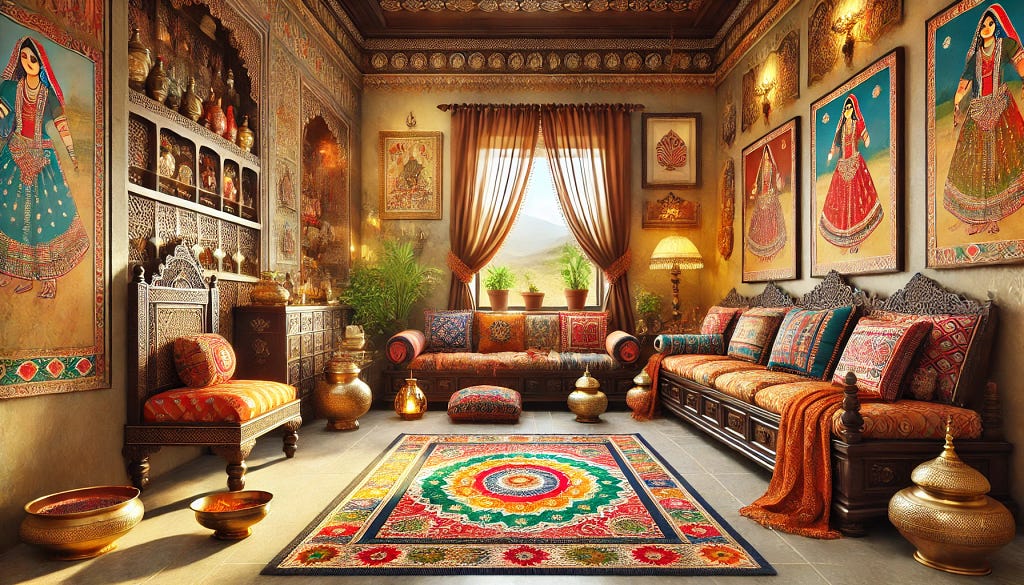
Coming Home: The Next Big Opportunity for Indian D2C Brands
Walk into any Indian metropolitan home today, and you’ll witness a quiet revolution unfolding. Gone are the days when functionality trumped aesthetics, when homes were merely spaces to inhabit rather than canvases for personal expression. In living rooms across Mumbai, Bangalore, and Delhi, young professionals are curating Instagram-worthy interiors, elderly couples are reimagining spaces they’ve called home for decades, and families are discovering that good design isn’t a luxury — it’s a necessity.
Source: Praxis
This transformation reflects something far bigger than changing tastes. India’s home and interiors market, valued at $29.5 billion, is racing towards becoming a $48 billion market by 2028 — a growth story powered by urbanization that’s reshaping skylines, a generation that views their homes as extensions of their identity, and technology that’s making sophisticated design accessible to the masses. For startups and investors watching this space, the question isn’t whether this market will explode, but how quickly they can position themselves to ride the wave.
Source: Praxis
India is Witnessing Strong Macroeconomic Fundamentals Driving Discretionary Consumption
Source: IMF
India’s economic transformation is reshaping consumer behavior, with per capita GDP rising from $1,430 in 2012 to $2,380 in 2022 (5% CAGR), and projected to grow at 8% CAGR to $3,470 by 2027P. Though still modest compared to the U.S. ($76,350) or China ($12,810), this trajectory is fueling a rise in discretionary consumption.
Source: Redseer
The shift in household income distribution is accelerating premium consumption, with higher-income households expected to grow 1.5x over five years. This upward mobility is altering the consumption landscape as affluent consumers spend more on non-essentials.
Source: Stanley Lifestyles DRHP
Discretionary retail is expected to grow at an 18% CAGR from 2022–25P, compared to 5% for non-discretionary spending, increasing its share of total retail from 32% in 2017 to 34% by 2025P.
Source: Stanley Lifestyles DRHP
Despite comprising just 2% of households in 2022, affluent families accounted for 10% of India’s $2.1 trillion Private Final Consumption Expenditure (PFCE), underlining their growing influence. This is fueling a premiumization trend across sectors, positioning high-value goods and services for continued growth.
Source: Stanley Lifestyles DRHP
With Economic Expansion, There is a Massive Uptrend in Demand for Real Estate, Reflected by The Growth in Housing Finance
Source: Praxis
India’s housing finance sector is booming, reflecting the rising aspirations of a growing middle class. Higher-value loans (above INR 5 million) have grown at a 26% CAGR during FY21–23, indicating increased access to credit and demand for premium housing.
This marks a shift toward homeownership among upwardly mobile consumers, especially in urban and semi-urban areas, signaling deep structural changes in financial behavior and lifestyle aspirations.
Demand for Premium Homes is on the Rise and is One of The Fastest-Growing Segments in Housing Sales
Source: Redseer
India’s real estate market is experiencing a premium shift, with overall residential sales growing from 3.7 million units in FY19 to 5.1 million in FY23P.
Premium and luxury housing (priced above ₹1.5 crore) is growing at 22% CAGR — far outpacing the 3% CAGR in affordable housing. Market share for premium/luxury homes has doubled from 1.7% to 2.8%, and high-end homes (₹0.8–1.5 crore) rose from 2.1% to 7.4%. Affordable housing’s dominance has declined from 88.7% to 71.3% of total sales, while the mid-end segment grew at a 36% CAGR to reach 18.5% share.
Source: Redseer, Anarock
Cities like Mumbai, NCR, Hyderabad, Bengaluru, and Pune are seeing surging demand, with premium sales more than doubling across metros — Mumbai alone grew from 12,900 to 31,100 units sold in FY19–23.
Source: Redseer
India’s Home and Interiors Market is Expanding Rapidly in Tandem With Housing Growth, Catering to a Design-Conscious Consumer
Source: Praxis
India’s home and interiors market is witnessing robust growth, valued at INR 2.4 trillion (US$29.5 billion) in 2023 and projected to reach US$48.1 billion by 2028, driven by a booming housing sector. The market splits into home furnishings (48% share), covering furniture, mattresses, and textiles, and home improvement (42%), including tiles, flooring, and fittings. This expansion aligns with the surge in metro city housing project launches in 2023, creating demand for diverse interior solutions. Consumers are increasingly design-conscious, seeking products that reflect modern aesthetics and personal style.
Source: Stanley Lifestyles DRHP
The home goods market demonstrates an evolution toward branded offerings. The branded segment’s share has grown from a mere 5% ($0.2 billion) in FY17 to a projected 17% ($3.6 billion) by FY27P, representing an impressive 41% CAGR.
Meanwhile, standalone products, while still dominant at 83% market share, are growing at a more modest 21% CAGR. This gradual but persistent shift toward branded home goods reflects consumers’ increasing willingness to pay premiums for trusted brands and superior product quality.
Source: Stanley Lifestyles DRHP
Similarly, the interior market data reveals a dramatic shift toward organized retail, with the organized segment expected to grow at a robust 23% CAGR compared to just 13% for the unorganized sector.
This transformation is evident in the changing market composition — while unorganized players dominated in FY23 with $16.8 billion versus $4.2 billion for organized retailers, the gap is projected to narrow considerably by FY27P, with organized retail reaching $27.4 billion against $9.6 billion for unorganized players.
Together, these trends signal India’s transition from a price-sensitive, fragmented market to one that increasingly values organization, branding, and modern retail experiences.
Such an expansion is being driven by a confluence of several growth drivers, further unlocking this latent opportunity:
Higher Disposable Income: Rising GDP per capita, from US$1.3K in 2010 to US$2.6K in 2023, has doubled disposable incomes, fueling demand for high-quality, aspirational home products in a market projected to reach US$48.1 billion by 2028.Growth in the Real Estate Sector: A 20% surge in metro city project launches in 2023, compared to the previous year, reflects robust real estate growth, driving demand for furnishings and home improvement solutions.Decrease in Renovation Cycle: The average renovation cycle has dropped from 15 to 10–12 years, with evolving family needs driving updates, particularly in kitchens and bathrooms, creating opportunities for new trends.Change in Customer Preferences: Younger homeowners, with ages dropping to the early 30s due to urbanization, prioritize aesthetics, boosting spending on premium products like bedroom furniture (41% market share) and mattresses (20% CAGR from 2019–22), alongside a surge in DIY trends for decorative paints and tools.Increasing Trust in Professionals: Growing reliance on design consultants and 3D design model visualization reflects increased consumer confidence in professional services, enhancing engagement and innovation in the sector.
As these growth drivers converge, the home and interiors market presents a fertile ground for brands and investors to capitalize on India’s evolving consumer landscape, paving the way for sustained expansion.
A Dynamic Mix of Traditional Players and Digital-First Brands Is Shaping the Home and Interiors Ecosystem
Source: Praxis
The Indian home and interiors market comprises a complex ecosystem where traditional giants, digital-first innovators, and omnichannel players compete across distinct segments. With indoor living commanding a large market share and design overtaking durability as the top purchase criteria, each sub-segment reveals unique competitive dynamics and emerging opportunities.
Home Furnishing: Design-Led Transformation
Indoor Living dominates with space-maximizing solutions, driving growth:
-> Smart furniture integration: USB-enabled recliners commanding price premiums as home offices become permanent fixtures
-> Sustainable materials adoption: Bamboo and recycled wood are gaining traction among eco-conscious consumers
-> Experience-first retail: Brands like Fabindia are creating integrated wellness centers while IKEA drives the “retail box model” with room-specific solutionsMattresses benefit from accelerated replacement cycles (10 years to 7.7 years):
-> Technology premiums: Memory foam variants commanding price premiums over traditional coir mattresses
-> Direct-to-consumer dominance: Online brands leveraging sleep-trial periods and subscription care services
-> Health-focused innovation: Hypoallergenic and cooling gel technologies addressing wellness trendsLighting transformation led by LED dominance:
-> Smart integration surge: Voice-assisted chandeliers seeing price premiums over traditional fixtures
-> Sustainable design: Terracotta and bamboo lighting fixtures appealing to conscious consumers
-> Energy efficiency focus: Consumers prioritizing decorative yet energy-efficient solutions
Home Improvement: Innovation Meets Functionality
Paints & Hardware is experiencing material innovation:
-> Functional paints emergence: Self-cleaning, anti-bacterial, and glow-in-dark variants responding to lifestyle needs
-> Eco-conscious shift: Low-VOC paints gaining traction among health-aware consumers
-> Omnichannel leadership: Asian Paints integrating experience centers with digital color visualization toolsWall & Floor Covering embracing alternative materials:
-> Sustainable options: Coco tiles, strand woven bamboo flooring, and leather scrap tiles targeting niche segments
–> Premium positioning: Natural materials commanding higher margins through sustainability messaging
-> Installation integration: Traditional dealers expanding into design consultation servicesSanitary Ware premiumization with mid-range bathroom spending increasing rapidly:
–> Smart bathroom solutions: Sensor faucets and automatic closets becoming standard in premium segments
-> Experience centers: Kohler and Hindware showcasing complete bathroom ecosystems
-> Spa-like experiences: Multifunction showers and LED-integrated fixtures driving category upgrades
Services: Technology-Enabled Growth
Digital transformation reshaping service delivery:
-> AI-powered design: 3D visualization and virtual consultation becoming industry standard
-> Subscription models: 7-step mattress care and quarterly maintenance plans are gaining adoption
-> Community engagement: Facebook communities and experience-sharing platforms, building brand loyaltyInstallation integration becoming a competitive advantage:
-> Omnichannel service: Seamless appointment booking through mobile apps
-> Smart home integration: Remote diagnosis capabilities for connected appliances
-> Personalized consultation: Traditional designers competing through specialized expertise
Retailers: Omnichannel Imperative
Channel strategy evolution driven by consumer behavior shifts:
-> Direct traffic dominance: Leading brands are achieving higher direct traffic as compared to laggard brands
-> Experience center expansion: Physical touchpoints crucial for high-involvement purchases
->Technology integration: AR/VR becoming standard in furniture and flooring selectionMarket access democratization
-> E-commerce enablement: Smaller brands leveraging platforms for broader reach
-> Quick commerce expansion: Rapid delivery becoming a competitive advantage in categories like tools and hardware
-> Hybrid models: Buy-online-pickup-in-store bridging digital convenience with physical experience
The ecosystem reflects India’s broader economic transformation, where rising disposable incomes and shortened renovation cycles create opportunities for players who can balance digital innovation with experiential retail, while addressing the fundamental shift from utility-focused to design-driven consumer preferences.
The Sector is Witnessing Transformative Trends Shaping up the Entire Landscape of Home and Interior Offerings
Source: Praxis
The Indian home and interior market is experiencing a paradigm shift driven by seven key trends that are reshaping consumer expectations, product offerings, and industry dynamics:
Optimizing Space Efficiency: Consumers seek practical and ergonomic designs, with features like counter-top basins in bathrooms, modular kitchens with built-in lighting, ergonomic home office setups, and versatile kids’ rooms with interactive elements.Evolving Consumer Preferences: Focus has shifted to personal expression through minimalist/maximalist styles, warm tones, and sustainable materials; design now outranks durability, with mattress replacement cycles dropping from 10 to 7.7 years by 2022.Digital-Driven Brand Engagement: Social media and e-commerce platforms lead discovery; brands offer immersive experiences (e.g., Hindware’s Lacasa stores), with 45–47% direct traffic showing strong consumer loyalty.Elevating Product Value: High-end products like memory foam mattresses (75% price premium) and voice-activated chandeliers (85% premium) are gaining popularity, alongside eco-friendly options like upcycled textiles and mango wood furniture.Advancing Material Sustainability: Eco-conscious materials like self-cleaning paints, coco tiles, bamboo flooring, and smart lighting with terracotta/jute components blend performance with environmental responsibility.Stricter Regulatory Standards: Upcoming Quality Control Orders enforce load requirements (e.g., beds at 110 kg) and fire-resistant upholstery, raising costs but enhancing quality and cutting non-compliant imports by 22% in FY22–23.Global Manufacturing Ambitions: Exports rose from $3.1B to $5.7B (12% CAGR, 2017–22), with the U.S. as the top market (18% CAGR), positioning India as a global design leader while imports stay steady at $3.3B.
These trends collectively represent a fundamental shift in the Indian home and interior market — from a primarily functional, price-driven sector to a sophisticated, design-conscious, technology-enabled, and sustainability-focused industry that balances local consumption needs with global market aspirations.
Source: Praxis
The Sector Has Seen Multiple Interesting Deals and Solid Interest from Investment Funds
Source: Tracxn
India’s home and interiors sector has attracted significant investor attention, with multiple funding rounds demonstrating strong confidence in the market’s growth trajectory. Recent investment activity spans various sub-segments, from established players to emerging startups, with funding rounds ranging from seed investments to large Series A rounds. The sector has witnessed high valuation multiples at times, indicating investor willingness to pay a premium for companies with proven traction in this space.
The investment landscape reveals several key macro trends shaping the sector. Premium home décor and lifestyle brands are commanding strong valuations and attracting established institutional investors, while technology-enabled platforms focusing on digital solutions are gaining significant traction. There’s growing interest in sustainable and specialty segments, with multiple startups receiving backing from prominent venture capital firms across different investment philosophies.
This funding momentum, supported by diverse investors ranging from corporate venture arms to specialized funds, aligns with India’s premiumization trends and rising discretionary spending, positioning the sector for continued expansion and innovation.
“India at Home” Is At An Inflection Point, Presenting a Multi-Billion-Dollar Opportunity for Investors and Entrepreneurs Alike
India’s home and interiors market is poised for transformation. Shorter renovation cycles of 10–12 years drive demand for interior design, bath-tech, and kitchen appliances, while design-conscious consumers leverage social media to discover brands. Many imported smart-home and appliance products fail to meet Indian needs, creating space for localized innovation, though broad smart-home adoption remains limited beyond security solutions. Digital-first brands and quick-commerce platforms are reshaping categories like furniture and decor, offering opportunities for category creation.
Regulatory tailwinds, such as BIS norms from 2025, will enhance product quality, while Indian exporters are set to serve global markets. Entrepreneurs can capitalize on unorganized segments like furniture with unique designs, and marketplaces can differentiate through services like home styling. Investors should back sustainable, premium, and digital-first brands to unlock this multi-billion-dollar opportunity.
The Indian home is no longer just a place to live — it’s becoming a statement of aspiration, identity, and possibility. As the market races toward $48 billion by 2028, the real story isn’t about the numbers. It’s about the young entrepreneur launching a sustainable furniture brand, the tech startup democratizing interior design through AI, and traditional craftsmen finding global audiences through digital platforms.
This convergence of tradition and innovation represents more than market opportunity — it’s the foundation of India’s next consumer revolution. The brands that will win aren’t just those with the biggest war chests, but those who understand that Indian consumers aren’t just buying furniture and décor; they’re investing in dreams and the life they want to build within their four walls.
If you are a founder building in the home and interiors space, and are looking to raise capital or explore M&A opportunities, please reach out to udayan@loestro.com, we’d love to have a chat.
LoEstro Advisors is an investment banking firm specializing in sell-side fundraising and M&A advisory, along with a strong consulting arm. Recognized as the #1 financial advisor in education in India, we are the advisor of choice to India’s blue-chip education businesses.
Over the last four years, we have grown to be one of India’s largest (in terms of M&A transactions) homegrown boutique investment banks, with $1.25 bn+ worth of combined deals closed across education, healthcare, consumer, and technology sectors.

